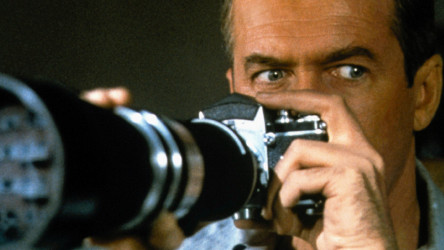Into Film Clubs
Find out everything you need to know about starting an Into Film Club.


We're delighted to announce that our latest Film of the Month winner is suspenseful thriller Suburbia, from filmmaker Jack in West Sussex. Watch the winning film above.
Suburbia takes to a suburban neighbourhood where all is not what it seems, as a series of vignettes reveal a dark secret lurking at the heart of the seemingly genteel location.
This is an incredible achievement. To work in black and white and shoot at night is difficult for any director/cinematographer, so to come out with something that looks as aesthetically distinguished as this is fantastic.
Film of the Month judge on 'Suburbia'
We got in touch with Jack to find out more about his film.
I've been making films for what seems like my entire life; certainly as far back as I can remember. But I believe I began to truly show an interest around the age of 9/10, and I am 17 now, so you can imagine that I've certainly had time to learn and grow as a filmmaker. I've always had an interest in telling stories and exploring creative ideas, whether that be through writing, painting, photography, or theatre. But film, to me, has always been the ultimate storytelling medium, and I certainly won't stop making films anytime soon.
It actually began as I was editing a photograph I'd taken of my dog through my living room window. I shot the photograph in black and white, and as I was examining it, I felt an ominous and almost voyeuristic sensation about it; as though I were prying upon a private life. It was taken at night, so everything around the window was pitch black, making everything seem isolated and eerie.
For me, the next logical step was to create a film from this photograph, and attempt to replicate and provoke the same feelings surrounding the photograph. I wanted to experiment with narrative and character, and so I came up with the idea of creating almost a visual poem; a completely non-linear film that didn't aim to tell a singular story, but multiple stories that intertwine with one another, and help to create an overall feeling and tone, through juxtaposition, ellipsis, and other editing techniques that could achieve unique affects.
The end result worked marvellously, and managed to provoke the exact same sensations brought upon by the initial photograph, so I feel my ideas worked well.
There is a technique in film known as 'contrapuntal sound' where the sound/music that the audience hears completely contradicts the actions taking place on-screen. I wanted to utilise this effect, as it helps to seamlessly create a tone of absolute unease and dread for the audience, which is essential for the overall atmosphere of the film. I also wanted to take into account the fact that the film was set within a suburban setting with characters, locations, and an overall mise-en-scene that would seem very familiar and truthful to the audience.
And yet, the actions that take place and the way in which characters act is rather theatrical and extravagant, and I wished to emulate that sensation with the music and so, a classical Waltz seemed to fit best, as it created an almost operatic sense of theatricality that perfectly juxtaposed with the familiarity of the setting.
Shostakovich's waltz was perfect in this regard, as whilst it is dramatic and simply wonderful to listen to, there is still the slight sensation of unease when you listen to it, which I think just works brilliantly for the atmosphere of the film.
There are some huge advantages when working in black and white, both practically and from a storytelling perspective. Most obviously I didn't have to worry about colour when making the film, meaning I could focus solely upon the lighting and tone of each shot, ensuring that the highlights, shadows, and overall contrast was perfect, without the distraction of maintaining colour palette and white balance.
It also meant I could work within more difficult low-light conditions, without obvious digital noise from my DLSR or chromatic distortion from my lenses. I could also use far more contrast when colour-grading each shot in post, as black-and-white looks far better when in deeply contrasted conditions than coloured video, as when the contrast of coloured video is increased too much the colours become over-saturated and visually displeasing.
However, the main reason I chose to shoot in black-and-white came from my love of the Film Noir and German Expressionism movements in film, with their deeply contrasted images creating an eerie and thrilling aesthetic that keeps the audience in suspense at all times. I wanted to apply that same aesthetic to Suburbia, but instead of focusing upon corrupt detectives or the monsters of the night, I instead applied the aesthetic to a familiar setting, that to the audience, is a little too close to home…
Well, my vision was always from the beginning to open the film with a shot that looked inwards to the suburban home from the outside world, and then to flip the shot at the end to be looking away to the outside world from inside the suburban home; displaying the freedom one feels when separated from the horrors that dwell within suburbia.
I simply got incredibly lucky, as during the two weeks of production, it was forecast to snow throughout the week. With me living in the south east of England, we very rarely see heavy snowfall - if any at all - and so I would pray every night that week that at least some snow would fall so that I could shoot the final scene with the snow (just to add the extra sense of atmosphere and freedom for the final shot). Luckily, the snow did eventually fall, and I was ready for it when it did!
I believe I would try to focus upon a wider range of people within the film. Don't get me wrong, the ensemble is already rather massive within the film, but I feel that focusing also upon, say, an elderly couple, or a young child/toddler, or perhaps even a businessman of sorts, would make the film far more universal to a wider audience. The larger the demographic represented, the better in my opinion.
Oh, I have near-endless favourite filmmakers, with Stanley Kubrick being my absolute favourite, closely followed by Tarkovsky, Coppola, Scorsese, and Tarantino. I also have a soft spot for Orson Welles, Charlie Chaplin, and George Meliles, and in recent years Paul Thomas Anderson, Denis Villeneuve, Wes Anderson and the Coen Brothers (like I said - near endless!).
In terms of who influenced me the most for Suburbia, it would have to be Hitchcock and the immaculate direction and cinematography of Rear Window. He perfectly demonstrated the power of voyeurism and the tension that could be created by watching private affairs from afar, and I felt that emulating his style would be perfect for Suburbia. I also took many of the cynical and theatrical elements of Kubrick's films, with his taste for unsettling and eccentric characters, and the unification of both objective/naturalistic filmmaking and subjective/expressionistic filmmaking.
Jack's film will now be showcased to over 300,000 film club members online and all of our Film of the Month films are now on the Into Film YouTube channel, and he has also secured a £100 Amazon voucher to help further develop his future films. Think you could win Film of the Month? Find out more about how you can enter our ongoing Film of the Month competition.
If you've been inspired by Suburbia then make sure you check out these related films:

Stream on Into Film+
This Alfred Hitchcock thriller sees a reporter stuck in his apartment with a broken leg, and seeing suspicious activity out his window.
Certificate
Viewing 4 of 4 related items.

Get in touch with your article ideas for the News and Views section.